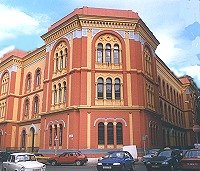The other side of the Hungarian Jewish question

What is the bottom-line of Hungarian anti-Semitism?
Get The Times of Israel’s Daily Edition by email
and never miss our top stories FREE SIGN UP!
Ignorance. Hungarian anti-Semitism is mainly not against the Jews themselves. In the economical crisis radicalism grows in Hungary.
The government of Hungary is led by Fidesz that won the last elections in 2010 by 51%. The party fights for power with demagogue speeches, trying to convince everyday people about their life being better than before Fidesz got to power (when, in fact, the production of the building industry, for example, has fallen by 60% compared to 3 years ago – this is only an example, but there is a significant fall in all areas of life quality).
Officially, on the level of statements and formalities, Fidesz condemns all kinds of extremism, but they are acutely inconsistent in their acts. For example, it was the Fidesz government that introduced the National Holocaust Day (16 April – in 1944 the ghettoisation started on this day) and that established the Holocaust Museum, but at the same time the speeches of Fidesz politicians often contain hidden anti-Semitic references, like references to “genetics”, or the guilt of the government of “bankers” in any economic crisis. An openly racist can receive a state award. Books of anti-Semitic writers are recommended in the public school syllabus. In general, in order to maintain their support, they feel that they need the support of the right –far-right voters on the political palette, and thus they try to balance empty gestures with speeches and statements that echo well among far-right voters.
The people of Hungary become more and more nervous, distracted and hungry. The Fidesz literally works against the Hungarian people, it has machiavellian tactics for gaining power. Anti-Semitism is one of the forms in what this greed shows.
The most recent act of the Hungarian Government articulating its intentions of faking history to justify the Hungarian participation in the nazi regime and not acting as nazis by the country’s free will was that it pronounced as a case of extraordinary significance Statute 565 – the execution of the Memorial of the German occupation of Hungary. The memory of victims – all Hungarian victims – is indeed of extraordinary significance, it must be creditably commemorated. However, the Hungarian Government intends to commemorate the German occupation, not the victims on the occasion of the 70th anniversary of the Hungarian Holocaust. The Federation of the Jewish communities and a number of Jewish organizations protested against Statute 565. The case is still in process.
Is the Hungarian government against Israel?
No.
Than why doesn’t the government stop the rise of anti-Semitism?
In order to stay in power at the upcoming elections in April 2014, the government builds their support from right and far-right voters. Their competition on the far-right Jobbik, is an openly racist and ethnicist party showing their emotional trauma when using the word neo-Nazi for describing them. In order to win over the sympathy of Jobbik’s potential voters Fidesz has a tendency of overlooking their anti-Semitic moves. As such, public expressions of anti-Semitism seem to become acceptable, and in some circles even trendy. Thus latent anti-Semitism – already triggered by the economic crisis – surfaces more and more often.
Is the Muslim community dangerous to the Jews in Hungary?
No. There is only a small Muslim community in Hungary, and it does not represent a real threat to the Jews.
Is anti-Semitism the only form of racism that rises in Hungary, or are there other forms?
The major problem, with significant verbal and physical abuse and discrimination, is racism against Gypsies.
Is there any organization in Hungary that fights against anti-Semitism?
Yes. There is a broad range of short- and long-term methods (from flash-mobs to formal and informal education) implemented by very well armed people, who mostly sacrifice their free time as volunteers. These manage to reach, and sometimes even mobilize a significant amount of people.
One of the most visible and successful such event is the March of the Living (Az Élet Menete). In 2013, 30,000 people participated in the Budapest March of the Living, regardless of their religion, political opinion and ethnic / national origin, to remember the 600,000 Hungarian Jewish victims of the Holocaust, and to remind the next generation that it should never happen again. Besides the yearly March of the Living, MOTL Hungary also runs a unique Railcar Exhibition, which is an original cattle-wagon from the time of the deportations travelling to railway stations across Hungary functioning as a mobile exhibition unit that may be visited by students free of charge.
The Haver Foundation teaches students about Judaism in public schools, with the goal to prevent preconceptions and prejudice.
The Zachor Foundation endorses Holocaust education in Hungarian schools, holds teacher training courses, organizes tours for teenagers of Jewish Budapest.
The B’nai B’rith Budapest Lodge strives to improve the reputation of Hungarian Judaism.
Music Against Racism (ZARE) holds concerts with ethnic bands against everyday racism.
The Kurt Lewin Foundation spreads the idea of democracy and tolerance in the frame of company trainings.
“You can act!” (TETT) brings Roma and Jewish youth together.
There are other major organizations fighting for tolerance: The Alliance of the Hungarian Resistants and Anti-fascists (MEASZ), Association of the Persecuted by the Nazis (NÜB), the Hungarian Association of Inmates of Labor Camps (MOE), the Carl Lutz Foundation, the Wallenberg Foundation, the Foundation for Subjective Values (SZÉA), the Congregation of the Faith (Hit Gyülekezete), Exclamation Point Student Association (Kiáltójel Diákegyesület), Act and Shielding Foundation (Tett és Védelem Alapítvány), the Alliance of Christian Intellectuals (Keresztény Értelmiségiek Szövetsége), the Christian–Jewish Society (Keresztény–Zsidó Társaság). And this list is far from complete.
How can we help the fight against anti-Semitism in Hungary?
On a political level and by letting the aforementioned organizations learn and receive tools and channels to fight against anti-Semitism. To act against anti-Semitism is not the task of the Jews and the civil organizations but the political establishment.
Should we have concerns for the Hungarian Jewry?
Yes. But and because, Jewish life in Hungary is alive, more than anywhere else in Central-Eastern Europe. Moreover, the Hungarian Neolog is a unique branch of Judaism.
What is the ‘Neolog’?
The majority of Hungarian Jewry belongs to the so-called Neolog stream of Judaism. The Neolog movement was formed in the second half of the 19th century, in the days of the Austro-Hungarian Empire, as the result of the Enlightenment. When established, it was the Hungarian branch of the Reform movement, with similar, if not identical goals, practices and ideology, including their stance on secular education, liturgical reforms, changes in synagogue architecture. The Neolog synagogues were built to represent the openness towards other religions, several of them – including the famous Dohány, the Great Synagogue in Dohány Street – in a Moorish–eclectic style. Later on, and especially after the Holocaust, Neolog Judaism did not follow track, and did not adopt further reforms of the Reform and Conservative movements (such as their stance regarding egalitarianism for women and homosexuals in liturgy, for the rabbinate, etc.). Furthermore, in the last few decades the movement – and especially its younger generation of rabbis – has seen a tendency of becoming more traditionalist and conservative. The traditional stream within Hungarian Judaism is, nonetheless, still apparent. In the Neolog movement, there are separate women’s sections in synagogues, women are not included in the minyan, nor do they function as cantors or rabbis, men shave, married women cover their heads in the synagogue only (if at all), and although rabbis tend to be traditionally observant, the observance level of the communities is rather lax. Beside the Neolog movement, there are Orthodox, Masorti, Reform and Chabad communities as well in Hungary, with their own community infrastructures.
What does Hungarian Jewish community have to offer in a nutshell?
The number of Jews in Hungary is somewhere between 60.000 and 100.000. There are countless Jewish organizations, an Israeli Cultural Institute (unique in the world), the Balint Jewish community center and a a number of other Jewish cultural centers, more than 48 active synagogues, almost all existing Zionist youth movements, old age homes, a Jewish hospital, soup kitchens, Rabbinate of the National Defense, a Jewish Museum, a Holocaust Documentation Center, a Family tree research center, Jewish archives, a Jewish resort, kosher butchers, mikvah, sport clubs, Judaica shops, Jewish papers and websites, a Jewish program in the national television, a Jewish University with a Rabbinical Seminary, Jewish high-, and elementary schools (secular, Neolog, Orthodox and Chabad), various kindergartens, kosher restaurants, kosher stores. There are Jewish weddings, bar and bat mitzvah-s, brith mila-s. In Budapest, there is a vibrant Jewish life. Certain synagogues in Budapest are full on Shabbat, with more people than they were originally built for, others are full on High Holidays. On the other hand, in the Hungarian countryside, in major cities as Szeged, Debrecen, Miskolc, Győr, the minyan does need a serious support. In Budapest, at least one Jewish cultural event happens a day. Many among them are Holocaust remembrance events. There are six various Jewish cultural festivals in the course of the year. The International Jewish Summer Camp in Szarvas is very popular, and plays a significant role in forming and preserving Jewish identity. Children and their young leaders join the two weeks sessions from Eastern Europe, the USA, UK, and India.
Why does the Israeli media connect Hungary to anti-Semitism?
Because Hungary has traditionally been a right-wing country that chose to be on the nazi side in the second World War. And because racism in Hungary is currently public. After an anti-Semitic incident, nothing happens at the state level. While a large number of civilians demonstrate against it.
Read more: The other side of the Hungarian Jewish question | Eva Vadasz | Ops & Blogs | The Times of Israel blogs.timesofisrael.com/the-other-side-of-the-hungarian-jewish-question/#ixzz2sNcmXTI6
Follow us: @timesofisrael on Twitter | timesofisrael on Facebook














